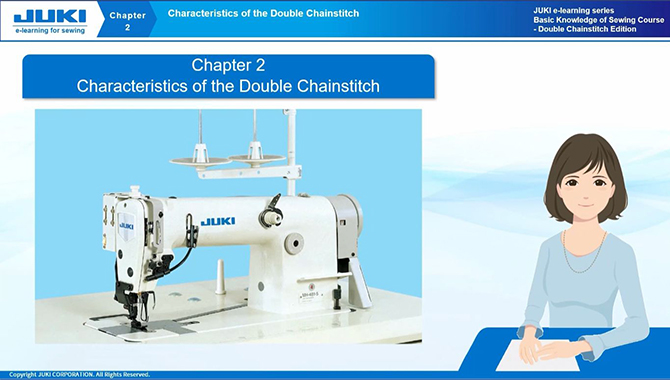Basic Knowledge of Sewing - Double Chainstitch
- Home
- Services
- JUKI e-learning
- Basic Knowledge of Sewing - Double Chainstitch
Course overview
- Course aim
- Focuses on the explanation of the main adjustment points (adjustment methods) that affect the formation of seams in double chainstitch.
The purpose of this course is to provide participants with the knowledge and skills to deal with stitching problems such as stitch skipping that may occur in actual sewing operation. - Target persons
- Sewing machine maintenance staff / Intermediate-level sewing operator
- Lecture time
- Approximately 240 minutes (Total video play time: Approximately 60 minutes)
- Supported language
- English / Japanese
Course details

Chapter 1 : "Basic Knowledge of Sewing" - Double Chainstitch
Learn about the seams that can be sewn with industrial sewing machines and the sewing problems that can easily occur.
Table of contents
- 1.1Types of Stitches
- 1.2Types of chainstitches
- 1.3Problems experienced in sewing process
- 1.4Summary

Chapter 2 :Characteristics of the Double Chainstitch
Learn about the characteristics of double chainstitch seam shapes and how double chainstitch seams are formed.
Table of contents
- 2.1Seam shape and characteristics
- 2.2Threading
- 2.3Formation of the double chainstitch seams

Chapter 3 :Adjustments
This course teaches how to adjust the needle bar, looper, thread spreader, needle guard, looper thread take-up cam, and feed dog which are the main adjustment points to form the seam of double chainstitch sewing machine.
Table of contents
- 3.1Needle height
- 3.2Looper action timing relative to the needle action
- 3.3Looper-to-needle distance when the looper moves forward to catch the needle thread
- 3.4Looper avoid motion
- 3.5Thread Spreader timing relative to the needle timing
- 3.6Thread Spreader position
- 3.7Needle guard and loop guide position
- 3.8Looper thread take-up cam timing
- 3.9Feed dog height and inclination
- 3.10Feed dog timing
- 3.11Sliding presser foot

Chapter 4 :Sewing problems and stitch skipping
Learn how to identify factors and take countermeasures when stitch ploblems or stitch skipping occur.
Table of contents
- 4.1The looper does not dependably catch the needle thread
- 4.2The needle does not dependably catch the looper thread (stitch skipping on the back side of the looper)
- 4.3Summary of sewing problems caused by incorrect settings

Chapter 5 :Summary
Summary of double chainstitch.


